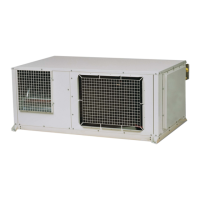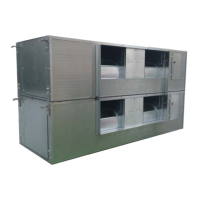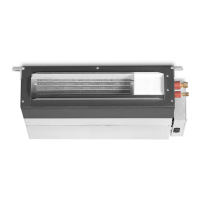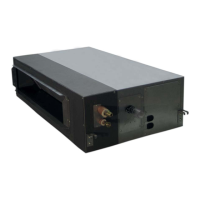Do you have a question about the Hitachi RPI-1.0FSG1 and is the answer not in the manual?
Details on setting rotary and dip switches for indoor and outdoor units.
Details on setting rotary and dip switches for indoor and outdoor units.
Procedures for checking power supply, intermediate, and operating line wiring.
Simple checks using the outdoor unit's 7-segment LED display.
How to perform emergency operation when the inverter compressor fails.
Troubleshooting steps for power failure and non-indicated lights/LCD.
Diagnosing and resolving issues with abnormal transmission.
Actions for device abnormalities when no alarm code is indicated.
Detailed procedures for troubleshooting issues based on alarm codes and system status.
Table listing alarm codes, contents of abnormality, and leading causes.
Detailed troubleshooting steps based on specific alarm codes.
Using the remote control switch's check mode for troubleshooting.
Troubleshooting using the outdoor unit's 7-segment display and check switches.
Explanation of the functions of Rotary Switches, Dip Switches, and LEDs on indoor unit PCBs.
Procedures for checking main components like PCBs and remote controls.
How to perform PCB self-checks using the remote control switch.
Step-by-step procedure for self-checking the remote control switch.
Procedures for self-checking indoor unit PCBs via relays.
Steps for performing self-checking on the 7-Day Timer.
Procedures for self-checking the central station.
Instructions for high voltage discharge work and checking other components.
Procedures for conducting test runs of the system.
Steps for initiating and performing test runs using the remote control.
Procedures for performing test runs directly from the outdoor unit.
Checklist for test operation and refrigerant cycle checks for FSG/FS3 series.
Procedures for servicing the outdoor unit components.
Instructions for removing the air intake grille from the outdoor unit.
Steps for removing the front service panel of the outdoor unit.
How to remove the fan guard nets from the outdoor unit.
Procedures for removing the outdoor fan assembly.
Steps for removing compressors for specific RAS models.
Procedures for removing compressors for various RAS models.
Steps for removing compressors for MC1 and MC2 models.
Procedures for removing compressors for MC3 and MC4 models.
Instructions for removing pressure-related components.
Steps to remove the reversing valve coil.
Procedures for removing solenoid valve coils.
How to remove thermistors for liquid piping.
Steps for removing the reversing valve.
Procedures for removing the reversing valve for specific models.
Instructions for removing electrical components for various models.
Steps for removing electrical components for specific models.
Servicing procedures for In-the-Ceiling type units (RPI models).
Procedure for removing the long life filter.
Steps to remove the PCB from the electrical box.
Instructions for removing the indoor fan and motor.
How to remove thermistors for liquid and gas pipes.
Steps for removing the electronic expansion valve coil.
Procedure for removing the float switch.
Instructions for removing the drain pump.
Steps for removing the drain pan.
Servicing procedures for higher capacity In-the-Ceiling units.
Procedure for removing the long life filter.
Steps to remove the PCB from the electrical box.
Instructions for removing the indoor fan and motor.
How to remove expansion valve and thermistors.
Servicing procedures for 4-Way Cassette type units.
Procedure for removing the long life filter.
Steps to remove the air intake grille.
How to remove the electrical box cover.
Instructions for removing the optional air panel.
Steps for removing the fan runner and motor.
Procedure for removing the bell-mouth.
How to remove the PCB from the electrical box.
Steps for removing the drain pan.
Instructions for removing the drain-up mechanism.
Procedure for removing the float switch.
How to remove thermistors for liquid and gas pipes.
Steps for removing the electronic expansion valve coil.
Instructions for removing the automatic louver motor.
Servicing procedures for 2-Way Cassette type units.
Procedure for removing the long life filter and air intake grille.
How to remove the electrical box cover.
Instructions for removing the optional air panel.
Steps for removing the fan runner and motor.
How to remove the PCB from the electrical box.
Procedure for removing the float switch.
Instructions for removing the drain-up mechanism.
Steps for removing the drain pan.
How to remove thermistors for liquid and gas pipes.
Steps for removing the electronic expansion valve coil.
Instructions for removing the automatic louver motor.
Servicing procedures for Wall Type units.
Procedure for removing the air filter.
Steps for removing the front panel.
Instructions for removing the automatic louver motor.
How to remove thermistors for various pipes and air sensors.
Steps to remove the electrical box cover.
Instructions for removing the indoor PCB.
Procedure for removing the drain pan.
Steps for removing the heat exchanger.
Instructions for removing the fan and fan motor.
Steps for removing the electronic expansion valve coil.
Servicing procedures for Floor Type units.
Procedure for removing the air intake grille.
Steps to remove the air filter.
Instructions for removing the discharge air grille.
How to remove the front cover.
Steps for removing the fan motor.
How to remove the PCB from the electrical box.
Instructions for removing thermistors for pipes.
Servicing procedures for Floor Concealed Type units.
Procedure for removing the air filter.
Steps for removing the front covers.
Instructions for removing the fan motor.
How to remove the PCB.
Steps for removing thermistors for pipes.
Servicing procedures for Ceiling Type units.
Procedure for removing air filter and intake grille.
Steps to remove the side cover.
Instructions for removing the discharge air grille.
Steps for removing the fan motor.
Procedure for removing the bearing.
Instructions for removing the coupling.
Steps to remove the automatic louver motor.
How to remove thermistors and expansion valve coil.
Procedures for checking the electronic expansion valve coil.
Steps to remove the PCB.
Maintenance and servicing of the total heat exchanger.
Overview of the total heat exchanger's structure.
Instructions for removing electrical parts.
How to remove the air filter and heat exchanger element.
Steps for removing the fan motor.
Guidelines for cleaning the air filter.
Procedures for cleaning the total heat exchanger element.
Procedures for cleaning the heat exchanger of various indoor units.
List of necessary tools for cleaning all indoor unit types.
Cleaning procedures specific to in-the-ceiling units.
Steps for cleaning 4-way cassette type indoor units.
Procedures for cleaning 2-way cassette type indoor units.
Steps for cleaning wall type indoor units.
Procedures for cleaning floor and floor concealed type units.
Steps for cleaning ceiling type indoor units.
Procedure for collecting refrigerant before replacing indoor units.
Specifications and arrangement of inverter power units.
Technical specifications for inverters operating on 380/415V and 380V sources.
Technical specifications for inverters operating on 220V, 60Hz source.
Diagram showing the arrangement of inverter power unit components.
Graphical representation of inverter operation timing and signals.
Details on the inverter's protective functions against voltage and current issues.
Explanation of overload control mechanisms for the inverter.
Concept and specifications of the AC Chopper for fan motor control.
Principles of operation and stoppage for auto-louver mechanisms.
Operation and stoppage principles of auto-louver for 4-way cassette units.
Explanation of auto-louver mechanism for 2-way cassette units.
Auto-louver operation and stoppage for ceiling units.
Auto-louver operation and stoppage for wall type units.
Details on scroll compressor mechanisms and principles.
Explanation of the scroll compressor's low vibration and sound mechanism.
Detailed steps explaining the compression principle of scroll compressors.
Description of the scroll compressor's structure and compressor types.
Information on thermistors used in indoor and outdoor units.
Positions and characteristics of thermistors used in indoor units.
Positions and characteristics of thermistors used in outdoor units.
Specifications and wiring for electronic expansion valves.
Specifications and wiring diagram for outdoor unit EEVs.
Specifications and wiring diagram for indoor unit EEVs.
High and low pressure control methods and sensor characteristics.
Explanation of the high pressure protection device and its circuit.
Specifications and circuit diagram of the noise filter.
Specifications for capacitors used in the inverter.
Specifications for reactors used in the inverter.
Optional functions for specific indoor unit models.
Provides control to stop/start systems automatically via remote signals.
Automatic start/stop based on power supply ON/OFF for disaster prevention.
Automatic restart after power failure exceeding 2 seconds.
Using an external thermostat instead of the indoor unit's inlet thermistor.
Unit control using average temperature from inlet thermistor and remote sensor.
Changing operation mode via external contact signal input.
Utilized to pick up operation signals for checking or interlocking with fresh air intake fan.
Optional functions for various indoor unit models.
Procedures for changing input/output settings via indoor PCB connectors.
Controlling temperature via remote control thermistor instead of indoor unit thermistor.
Stop and start system automatically from a remote place using various signals.
Automatic start/stop based on power supply ON/OFF for disaster prevention.
Automatic restart after power failure exceeding 2 seconds.
Using external thermostat instead of inlet thermistor for indoor unit control.
Unit control via average temperature of inlet thermistor and remote sensor.
Changing operation mode via external contact signal input.
Delayed start of total heat exchanger operation at interlock with air conditioner.
Utilized to pick up operation signals for checking or interlocking with fresh air intake fan.
Optional functions for outdoor units.
Handling of short-circuited demand input terminals for compressor stoppage.
Compressor and fan motor stop when forced stoppage input is short-circuited.
Controls compressor frequency based on outdoor running current limits.
Fixing operation mode to cooling or heating via external input terminals.
Operation of outdoor fans based on snow sensor input for protection.
Changing defrosting operation conditions via DIP switch settings.
Controls indoor fan operation during heating thermo-off cycles.
Enables year-round heating operation under high outdoor temperatures.
Enables year-round cooling operation under low outdoor temperatures.
Sets night shift operation for reduced sound levels, decreasing cooling capacity.
How to pick up alarm and operation signals from the outdoor unit PCB.
Overview and components of remote control switches.
Identification of parts and sections of the PC-P1H and PC-2H2 remote controls.
Controlling multiple indoor units simultaneously with one remote control.
Setting up main and sub remote control switches for dual control.
Procedures for setting various optional functions via remote control switches.
Details on optional functions available for remote control switches.
How to read unit address and refrigerant cycle number on the remote control display.
Overview and parts of the PC-LH3 wireless remote control switch.
Identification of parts of the PC-LH3 wireless remote control.
Procedure to identify indoor units installed side-by-side.
Controlling multiple indoor units simultaneously using wireless remote control.
How to operate the unit in emergency situations without the remote control.
Setting optional functions using DIP switches on receiver kits.
Details on optional functions configurable via wireless remote control switches.
Operation and self-checking procedures for the 7-Day Timer.
Overview and operation of the PSC-5S Central Station.
Case study on compressor failure caused by insufficient refrigerant charge.
Troubleshooting insufficient cooling due to long piping and incorrect settings.
Addressing high operating sound in in-the-ceiling indoor units due to airflow issues.
Troubleshooting system stoppage caused by alarm code '31'.
Addressing poor cooling due to insufficient outdoor unit installation space and air circulation.
Important considerations for designing and installing SET-FREE FXG/FX3 series.
Guidelines for selecting appropriate drain pipe diameters based on flow volume.
Precautions regarding refrigerant (HCFC gas) concentration limits and countermeasures.
Routine maintenance checks for indoor and outdoor units.
Data sheet for recording service and maintenance using the 7-segment display.
Data sheet for recording service and maintenance via remote control switch.
General checklist for service and maintenance tasks.
| Brand | Hitachi |
|---|---|
| Model | RPI-1.0FSG1 |
| Category | Air Conditioner |
| Language | English |












